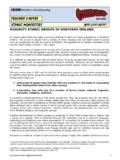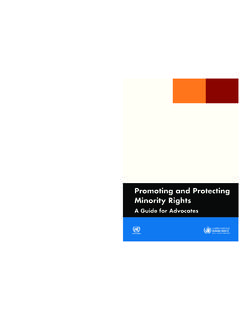Transcription of DIVERSITY BENCHMARKING REPORT 2016
1 DIVERSIT YBENCHMARKINGREPORT 20161 | City Bar BENCHMARKING REPORT | 2016 2016 DIVERSITY BENCHMARKING REPORT EXECUTIVE SUMMARY Signatory Firms See Gains for Women, Minorities, and LGBT Attorneys and Implement Innovative Inclusion Practices, Yet Barriers Remain For more than a decade, the City Bar BENCHMARKING research has illustrated enhanced DIVERSITY efforts in firms as well as overall incremental gains for women and minority attorneys. However, it has also recorded elevated attrition rates of both women and minorities, and a significant subset of law firms still without any minority and women attorneys in firm or department leadership roles. With regard to overall representation and hiring, the 2016 BENCHMARKING data remains relatively consistent with the results reported in 2015.
2 We further examined the status of women and minority attorneys in the 71 firms that participated in both the 2015 and 2016 BENCHMARKING surveys and performed statistical comparisons on representation, leadership, and hiring. The data did reflect changes in leadership metrics in 2016 , including a significant increase of women and minority representation on management committees, as well as notable increases in LGBT attorney self-reporting. Despite these advances, racial/ ethnic DIVERSITY at the partner level, erosion in the associate pipeline, and voluntary attrition remain challenges. Highlights of the research include: Women and minority attorneys made gains in leadership bodies, with the percentage of women serving on management committees increasing to from in 2015 and the percentage of minorities serving on management committees increasing to from in 2015.
3 The percentage of law firms with three or more women attorneys on the management committee increased from 24% in 2014 to 41% in 2016 , and the percentage of law firms with three or more minority attorneys on the management committee more than doubled from 7% in 2014 to 18% in 2016 . Still, nearly half of signatory firms have no racial/ ethnic minorities on their management committees and more than one-third have no minority practice group heads. In 2016 , white men represented 77% of all equity partners at signatory firms. Minority and women partners continue to be concentrated at the income partner level, rather than at the equity level. Moreover, the turnover rate for income partners in 2016 was , almost double the turnover rate of equity partners.
4 Overall representation of minority attorneys increased slightly to in 2016 from in 2015. 2 | City Bar BENCHMARKING REPORT | 2016 Erosion in the associate pipeline directly affects future leadership. 45% of associates are women compared to 19% of partners and 28% of associates are racial/ ethnic minorities compared to 9% of partners. By contrast, 43% of associates are white men compared to 76% of partners. Female attorneys represent 46% of junior level associates, but decline to 44% of mid-level women associates, and 42% of senior level women associates. Representation at the junior level increased, but minority representation has leveled off or declined for mid- and senior level associates: in 2016 , 36% of first-year associates were minorities dropping to 26% of mid-level associates, and 22% of senior level associates.
5 By the eighth year, only of associates were minorities. Voluntary attrition is down overall in law firms, but continues to disproportionately impact minority and women attorneys. of minorities and of women left signatory firms in 2016 150% and 135% above the rate for white men respectively. Even at the equity partner level, differences in voluntary attrition persist with rates of for women and for minorities compared to for white men. LGBT attorney representation has more than doubled since the City Bar began collecting data in 2004, from to , and representation of self-identified LGBT partners has doubled from in 2004 to in 2016 . Four percent of all attorneys used flexible work arrangements in 2016 9% of women attorneys and 1% of men attorneys.
6 Flexible work arrangements are used most frequently by Special Counsel attorneys, and 13% thereof are racial/ ethnic minorities. Signatory firms leadership continue to reflect increasing commitment to DIVERSITY and inclusion efforts, with 44% of firms reporting that a management committee member serves as chair of the DIVERSITY committee, an increase of seventeen percentage points from 27% in 2015. Signatory firms are implementing better practices, with a majority of firms providing attorney development opportunities with an enhanced focus on client relationships, and building more inclusive firm cultures. 3 | City Bar BENCHMARKING REPORT | 2016 Methodology & Updates In the 2015 update to the BENCHMARKING survey and REPORT , the City Bar incorporated several significant changes including participation in the survey as a prerequisite to being listed as a signatory, a breakdown of racial and ethnic data, and qualitative data including better practices and interviews with stakeholders at various firms.
7 This year s REPORT includes data from the 88 participating law firms a significant increase from prior years as well as more than 40 hours of qualitative interviews with law firm associates, partners, managing partners, clients, bar leaders, and DIVERSITY experts. Our mission is two-fold: first, to enhance and streamline our data collection efforts to define precisely the challenges that the firms are facing; and second, to foster greater industry-wide collaboration on model initiatives that yield meaningful results in the retention and promotion of women and minority attorneys. To this end, we have included detailed information on the better practices that can be adapted to align with each firm s unique challenges and goals.
8 We also sought to learn from the experiences of associates within these firms: in 2017, the City Bar launched its first Associate Leadership Institute, and included findings from participants in this year s REPORT . It is apparent from the qualitative research and featured initiatives that in order to effect change, law firms must make long-term, individualized investment beyond standard professional development options in the careers of minority and women associates whom they seek to retain. Embedding these practices in the firm culture can reframe such opportunities as an investment in the firm s future leadership, rather than necessary remediation, and provide partners with an array of options to support the firm s inclusion efforts.
9 We will continue to refine three key areas of the survey that require more thorough data: voluntary attrition, representation of attorneys with disabilities, and pipeline data. This REPORT includes the data collected in this year s survey, but we will conduct more detailed analyses of each area through relevant City Bar Committees and Task Forces with the goal of offering enhanced data and recommendations. We are most grateful to our signatory firms for embarking on this bold journey with us, and believe this research is critical to guiding and informing the many stakeholders that seek to create a more inclusive profession. We hope that our research along with the individualized, confidential reports created for each participating firm will continue to offer tools to bolster each firm s efforts while also encouraging greater accountability, knowledge-sharing, and collaboration across the profession.
10 Photos from Associate Leadership Institute, J. McClinton (see p. 23) 4 | City Bar BENCHMARKING REPORT | 2016 PART I: QUANTITATIVE SUMMARY 5 | WOMEN & MINORITY LEADERSHIP 11 | ASSOCIATE PIPELINE 13 | LGBT ATTORNEYS & ATTORNEYS WITH DISABILITIES 14 | VOLUNTARY ATTRITION 16 | PIPELINE 17 | FLEXIBLE WORK ARRANGEMENTS 5 | City Bar BENCHMARKING REPORT | 2016 NOTABLE GAINS IN LEADERSHIP ROLES FOR WOMEN & MINORITY ATTORNEYS The 2016 BENCHMARKING data reflects increases in representation at the leadership level for women and minority partners, suggesting that sophisticated retention and promotion efforts have had a positive impact. However, the data highlights the effects of persistent attrition on the pipeline to leadership, as well as the underrepresentation of women and minorities at the equity partnership level.









